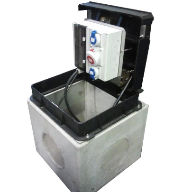Adding a power supply infrastructure to an outdoor public space, such as a courtyard or enclosed garden, is an excellent way to unlock the potential for holding events and creating more revenue-generating space.
But how can you ensure that the proposed power supply will meet the demands and needs of the site given the versatility that comes when an outdoor space is power-connected?
Over-specifying the services infrastructure and distribution units could be a costly mistake. But under-specifying could result in the need to hire temporary generators or run lengthy trailing cables from adjacent buildings, creating avoidable trip hazards.
Whether you are a site owner or an architect or landscape architect working to enhance an outdoor space, the starting point is to ask three basic questions about demand and needs:
1. How do you envisage that your proposed power unit or power distribution system will be used?
2. How many power sockets will be needed?
3. Would the location also benefit from a supply of data connectivity?
Designing-in versatility
Equipping any outdoor space with a power infrastructure is going to add a great degree of flexibility of use to the location. But when designing the power supply, it is important to have a picture of the typical and maximum usage that will be required.
Going back to basics, why is the site going to benefit from a power infrastructure? For a business such as a restaurant, bar, café or hotel, the outdoor space could add additional areas for eating and drinking primarily. Such uses would typically require the power distribution to provide access to sockets for lighting, till points, AV equipment or outdoor serving points such as mobile counters or drinks dispensers.
But is that the limit to such a site’s potential? Could it also be used as a stage are for outdoor music performances and other entertainment, for example. And if so, would your proposed power supply solution accommodate these requirements too?
Also think about the location of the power units in relation to how they will be used. If the site is to be used for market stalls, where will the stalls be set up on site and where will the main pedestrian routes be? Installing power units in the correct locations will help reduce the risk of trip hazards as cables trailing across the main footfall areas can be minimised or avoided completely.
Once you have a picture of how the site could be used, it is time to consider how you feed power to the locations across the space. This can be achieved with the installation of a Pop Up Power Supplies® power distribution unit in one of three forms:
• Pop up, retractable power unit – this is submerged in the group until it is needed and raised/lowered using a turning handle.
• Flip-lid, in ground power unit – this is permanently submerged in the ground with access provided via a flip-lid which can be used while the lid is locked down.
• Power bollard – a street furniture element which has power sockets integrated, accessible as required behind a lockable cover.
The type of power unit you choose will depend on how the site will need to look or be used when the space is not being used for events, catering, etc. Both the pop-up and in-ground units can be hidden away when they are not in use, with the only evidence being a cover which can be designed to match surrounding surface materials. A power bollard has a permanent presence, but the designs available from Pop Up Power Supplies® are elegant to avoid the utilitarian appearance that would be expected with a typical feeder pillar.
What should each power unit provide?
Consider what the electricity demand will be for the equipment that is to be connected to ensure the power supply units can handle the load. This is an area where Pop Up Power Supplies® has a wealth of expertise to help, given their experience of providing power units for a diverse range of sites across the UK, from Caerphilly Castle visitor centre to Chelsea FC’s Stamford Bridge pitch.
The retractable power units available from Pop Up Power Supplies® can be specified to provide a total power supply from as little as 63 amps right up to 600 amps. In ground units offer the option of 63 amps or 125 amps and power bollards provide up to 125 amps. The sockets in all can be configured to suit usage requirements.
These units can also be designed to provide a data connectivity.
For specification advice on this topic and any other technical support please email info@popuppower.co.uk or call 020 8227 0208.
Find out more about their range of solutions at http://www.popuppower.co.uk.
How to specify outdoor power distribution units to meet anticipated demand
| T | (020) 8227 0208 |
|---|---|
| F | (020) 8220 8838 |
| E | info@popuppower.co.uk |
| W | Visit Pop Up Power Supplies® Ltd's website |
| PO Box 1447, Ilford, Essex, IG2 6GT |
Products by this Company






